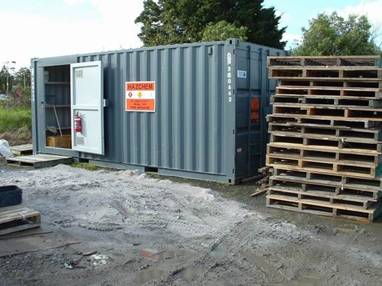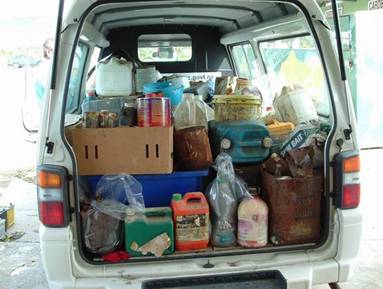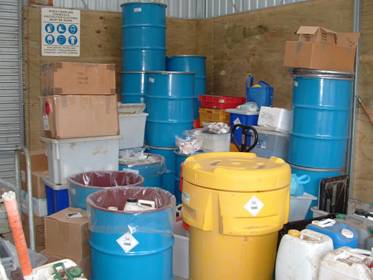Waste Hazardous Substances
Within this section…
The safe disposal of redundant or unused agricultural chemicals and other waste hazardous substances is an issue for all communities, especially given the limited disposal options available in New Zealand. Currently, only two commercial hazardous waste disposal facilities operate in the North Island, situated in Auckland and Wellington. While some New Zealand landfills offer co-disposal for low-key hazardous wastes, this option is not available in the Northland Region.
Some of the more hazardous agricultural chemicals held by farmers and horticulturists (especially Persistent Organic Pollutants (POPs) such as DDT, Heptachlor, Lindane or Dieldrin) cannot be legally disposed of in New Zealand. These chemicals require special disposal technologies, such as high temperature incineration, and must be shipped overseas.
Collection and Operational Depots
NRC and PGG Wrightson Ltd jointly operate four collection depots, located in Kaitaia, Waipapa, Dargaville and Whangarei. The PGG Wrightson collection depots accept agricultural chemical wastes only, which are documented before being placed in the store. To find out more about these facilities, go to http://www.nrc.govt.nz/Environment/Waste-and-pollution/For-farming/Agrichemical-collection/.
Once stored, the waste becomes the responsibility of NRC, who regularly transport it to the operational depot in Whangarei. The NRC depot is purpose-designed for waste hazardous substances. At this depot, the waste hazardous substances are repacked, labelled and placed in temporary storage until being dispatched to Auckland for long-term storage and eventual disposal.
To find out more about disposing of hazardous household waste, go to http://www.nrc.govt.nz/Environment/Waste-and-pollution/For-homes/Household-hazardous-waste/.

Wrightson's chem-shed at Waipapa
Spill and safety equipment is available on-site at all PGG Wrightson collection depots, in the event of an emergency such as the accidental spill of chemicals. NRC staff regularly update emergency procedures, as well as restocking equipment when necessary.
NRC also operates a mobile collection service where individual properties throughout Northland are visited to recover chemicals that may be leaking, require repackaging or are in a deteriorating condition. NRC also provides assistance and advice to private organisations requiring chemical disposal, including the collection of laboratory wastes from schools and industrial wastes (such as solvents and timber treatment sludges).
Waste Hazardous Substances Collected
During the 2007-08 financial year, approximately five tonnes of waste hazardous substances were collected for long-term storage, redistribution or pre-treatment. This figure is higher than for 2006-07, when four tonnes were collected.
The waste hazardous substances collected in the 2007-08 financial year included:
· Empty containers
Approximately one and half tonnes of empty containers were collected from throughout the region. These containers have not been counted in the total of hazardous substances collected. All containers were triple rinsed. The rinsate was then collected and disposed of through a specialist waste company in Auckland. The majority of the containers were shredded and disposed of by the same contractor.
· Insecticides and fungicides
Approximately one tonne (20% of the total) of insecticides and fungicides were collected from throughout the region, with the majority of these products originating from the Kerikeri area. Approximately 90% of the total volume of insecticides and fungicides collected were destroyed due to the deteriorating condition of the contents, or the labels being illegible and therefore the contents unknown.
· Persistent Organic Pollutants
Approximately 825 kilograms of POPs were collected (17% of the total). Some of the POPs handed in for destruction were particularly hazardous, including quantities of DDT, Chlordane, 245t, 24d dust and Mercury. All of these wastes have been sent overseas for destruction by high temperature incineration.
· Solvents and laboratory chemicals
Approximately one tonne (20% of the total) of used solvents and laboratory chemicals were collected from schools, commercial laboratories and commercial entities. In the case of solvents, the majority were reconstituted and recycled, while the laboratory chemicals were all disposed of through an Auckland based specialist waste management company.
· Herbicides
Just over 2 tonnes of herbicides (43% of the total) were collected from throughout the region, predominately from the four jointly owned and operated NRC and PGG Wrightson collection depots. Approximately 20% of the herbicides collected are still readily available on the market and legal to use. These were redistributed to land care groups and other organisations for weed control. The remainder of herbicides collected were in a deteriorating condition and were exported to Europe for destruction.

Collected waste hazardous substances
Agrecovery
Agrecovery is a New Zealand-wide plastic container stewardship, developed for the agriculture and forestry sector. It will give farmers and growers access to a sustainable and environmentally preferred disposal alternative to landfilling or burning their containers.
The programme will be funded on an ongoing basis by way of a levy on products put in the market by participating brand owners (agriculture and forestry product manufacturers). The Agrecovery foundation will manage all facets of the scheme.
Agrecovery has agreed to provide shipping containers or similar for the temporary storage of agrichemical containers. It is likely that these containers will be located near Kerikeri and in Whangarei. The programme will commence as soon as venues can be arranged.
Storage and Disposal of Waste Hazardous Substances
As mentioned previously, there are no facilities available in New Zealand for the disposal of many of the waste hazardous substances dealt with by the Council. As New Zealand produces a relatively small volume of waste hazardous substances, it appears unlikely that any New Zealand based disposal technology will become available in the short or long-term.
Under the Basel Convention, waste hazardous substances can be shipped elsewhere for disposal, at high temperature incineration units in Canada, Europe, or the United States for example. A French company, with a branch in Auckland, currently holds the licences for the export and destruction of NRC's waste hazardous substances.
Currently, NRC only has a small quantity of waste hazardous substances stored in Auckland, as the majority of its waste has already been sent overseas for destruction. The remaining waste hazardous substances are packed in UN approved containers and stored in licensed premises. NRC regularly inspects the integrity of the containers and their contents until they are sent overseas for destruction.
The photo below shows the packing shed, where waste hazardous substances are packed and sealed in drums for storage.

Chemicals in storage awaiting disposal
Hazardous Substances Compliance Inspections and Emergency Response
NRC staff also undertake inspections of work places in the region that store and use hazardous substances, in order to check compliance with the Hazardous Substances and New Organisms Act (HSNO) 1996.
During the 2007-08 financial year, 360 work place inspections were undertaken in Northland. The end of June 2008 marked the second year of a 3-year contract with the Department of Labour to undertake such inspections.
During the reporting period, the following work places were prioritised for inspection:
· Spray painters – automotive;
· Spray painters – polishers - furniture manufacturers;
· Printers;
· Retailers;
· Location Test Certificates – new; and
· Transit Depots.
In addition to work place inspections, an important component in the contract is to educate via information visits, the owners of premises storing and using hazardous substances. The aim is to increase the level of awareness of the HSNO Act as it applies to individual premises.
NRC also provides a 24 hour, seven day a week incident response team for incidents involving hazardous substances. In the 2007-08 financial year, a total of 27 incidents involving hazardous substances were attended by the Council's emergency response team.
